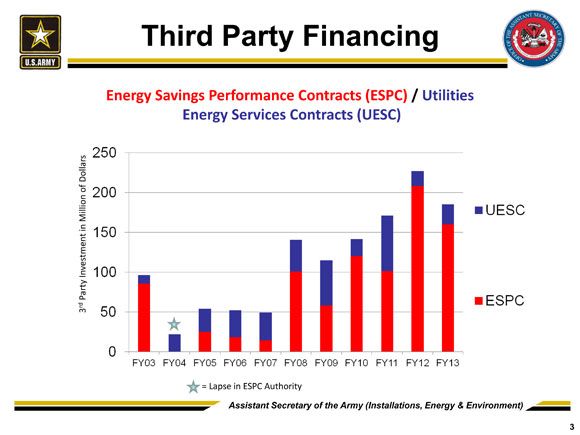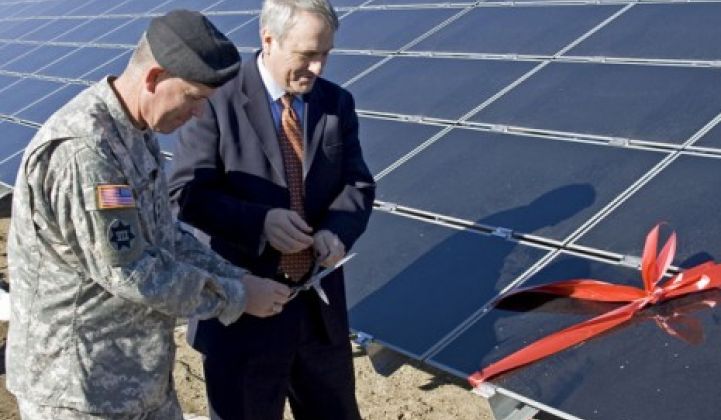News stories about the Army don’t always leave readers with a warm and fuzzy feeling.
But if you work in a clean energy industry, or are a taxpayer concerned about the U.S. Department of Defense’s $4 billion annual energy bill for its facilities, the recent policies and actions of the Army in this area are bound to make you smile.
The Department of Defense has ambitious targets for all branches of the military to be more efficient and use cleaner sources of energy. The DOD must reduce the energy intensity of its facilities by 3 percent annually and get 25 percent of its energy from renewables by 2025. Each branch has a goal of achieving 1 gigawatt of renewable energy in the same time frame.
The numbers in recent years show that the military has made promising strides toward these goals. From 2010 to 2012, the number of energy savings projects more than doubled to 1,339, and direct appropriations for energy conservation rose by 115 percent to $907 million. Renewable energy projects are up too, increasing by 54 percent to number 700 in 2012.
Every military branch has made progress, but it is the Army that is arguably out in front for now. And it’s not just competing with the Air Force, Navy and Marines. The Army leads the federal government in clean energy savings performance contracts. It has five times the number of any other government agency, according to Katherine Hammack, assistant secretary of the Army for installations and environment.
The advances of the Army and the larger DOD efforts are detailed in a new report from the Pew Charitable Trust, Power Surge. The report is the third installment of Pew’s research into the military’s clean energy policy.
Despite recent advances, the challenges are significant. Not only does supplying energy to bases all over the world cost a lot of money -- and sometimes lives -- but the military also saw 87 power outages in the U.S. that lasted more than eight hours in the period analyzed in the report. Power outages on the Army’s North American bases alone more than doubled from 2010 to 2011.
To increase resiliency, the military is moving toward more onsite generation, enhanced energy management and testing innovations in clean energy. An important recent step is that the DOD has started to embrace third-party financing to bring clean energy and energy efficiency to bases.
Performance Contracts Make Headway
The Army achieved record levels of third-party financing in 2012. Last summer, the Army announced up to $7 billion in solar contracts that would be handed out in coming years. Hammack said that behind the $7 billion is a pipeline of about 4 gigawatts of renewable projects that her branch was evaluating.
The Army has already awarded about $500 million in the past two years, and has already booked $75 million in utility and energy savings performance contracts in the first quarter of 2014, according to Hammack. In the past decade, the Army has reduced energy consumption about 16 percent.

But it’s a slow process that requires partners with patience.
"Third-party-financed solar has led to widespread adoption in nearly every segment,” said Scott Provinse, director of government programs for SunEdison, “but the government has struggled to transition to the PPA.”
Provinse would know. He pointed to a 166-megawatt power purchase agreement project that SunEdison developed at Davis-Monthan Air Force Base that is now commercially operational. It took three years to develop. One issue was bringing financiers to the table.
“We’ve really had to tap the deep relationship with our financiers to get them interested in federal projects,” said Provinse. Also, some projects have seen provisions in contracts that don’t really add value, but can cause project delays.
The DOD is aware of the delays and hurdles, and is looking to standardize the process so that the pipeline can be opened up.
“Some of the rules were drawn up to buy tanks,” said Hammack, “not to buy green electrons.”
Provinse agreed that many delays on large projects such as the one at Davis-Monthan have been solved.
"Stumbles and trips pose a threat, and until these [projects] are more standard, we need partners that can see these through,” he said. “The DOD has the drive and the commitment, but with more success will come more opportunity.”
Efficiency Is Only the First Step
As the details of military PPAs get hammered out, success is already being measured across the DOD. Hundreds of millions of dollars have been saved. The Army has cut its energy use by about 16 percent in the last decade.
But the federal government has far bigger designs. Executive Order 12514, issued in October 2009, directed that all of its buildings in the planning phase after 2020 should be designed to be net-zero energy.
The Army is not waiting around for 2020. It is exploring how all of its bases could become net-zero not only for energy, but also for waste and water. By the end of 2012, the Army had seventeen pilots at bases across the U.S.
The first step is to reduce energy waste and then maximize efficiency. For net-zero energy projects, the next step involves energy recovery and cogeneration that is then offset with renewable generation.
“Renewable energy is an endpoint,” said Hammack. The plans for net-zero water and waste are similar, with efficiency being the first phase. Water-related initiatives focus on switching to non-potable water for some applications, and waste reduction will involve more recycling techniques, such as composting.
After the pilots, the net-zero plans will be expanded to all permanent installations and then to forward-operating bases. One aspect of the Army’s push to net-zero bases is the use of microgrids. The Army has several microgrid projects now underway, but more are coming.
“Microgrids are a tool in the toolbox that we need to deploy more of,” said Hammack. The next step is to evaluate combined heat and power systems and renewables with microgrids.
One of the most significant struggles for the Army and DOD has been valuing energy security, said Hammack. She noted that when she used to work for American Express in the private sector, the company valued power outages at $1 million per minute. Once the DOD can put a value on energy security for military installations and the value of that resiliency to the surrounding community, the opportunities for clean energy and microgrids could be enormous -- and more tangible.
“It’s much more difficult to value that in the Army,” she said. “But we’re working hard at finding a solution.”



